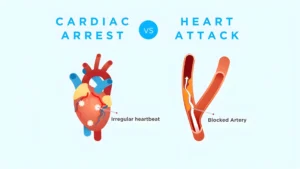Table of Contents

Many people confuse heart disease and cardiac arrest despite their differences, which can lead to fatalities during emergencies. Differentiating between these conditions is crucial for saving lives and providing appropriate care.
Cardiovascular diseases (Heart diseases) remain the leading cause of global mortality, accounting for 17.9 million deaths each year. The World Health Organization (WHO) reports that heart diseases are responsible for 3 out of every 30 deaths worldwide.
Heart attacks result from blockages in heart blood vessels, while cardiac arrest happens when electrical heart problems interrupt the heartbeats. These health crises need different emergency care and response time because of their distinct treatment.
This guide will show you detect warning signs and the primary causes of heart attacks and cardiac arrest while educating you on the necessary responses to save someone in need.
Here is a simple chart that explains the main differences between heart attack and cardiac arrest.
| Aspect | Heart Attack | Cardiac Arrest |
| Definition | A blockage in an artery restricts blood flow to the heart muscle, leading to a heart attack (myocardial infarction). | An electrical malfunction stops the heart from working properly enough, which leads to cardiac arrest. |
| Cause | Typically caused by coronary artery disease (blockage in arteries). | Often caused by abnormal heart rhythms (arrhythmias). |
| Symptoms | Chest pain, shortness of breath, nausea, sweating. | Sudden collapse, no pulse, no breathing, unconsciousness. |
| Onset | Gradual; Symptoms can appear hours, days, or weeks before. | Immediate; Occurs suddenly without warning. |
| Consciousness | Generally, the person is awake and responsive. | The person loses consciousness immediately. |
| Emergency Response | Call emergency services and provide aspirin if advised by a doctor. | Call emergency services and perform CPR immediately. |
People frequently confuse cardiac arrest with heart attacks, though they involve different medical issues. Understanding their differences enables us to provide appropriate care during emergencies. Here are some key points:
 Heart Attack:
Heart Attack:
A heart attack occurs when an artery obstructs oxygen flow to heart muscle tissue, creating severe circulation issues. Conversely, cardiac arrest refers to the heart losing its regular rhythm due to electrical instability. Without swift treatment, a heart attack can lead to cardiac arrest. Always call emergency medical services immediately upon observing chest pain, breathing issues, or sudden collapses.
A heart attack happens when blood flow to the heart is halted, cutting off its oxygen supply. Plaque buildup in coronary arteries blocks this flow. Without prompt treatment, the heart muscle sustains damage.
Heart attacks manifest as chest pain, breathing difficulties, nausea, and sweating, with pain radiating to the arms and jaw. Immediate medical assistance is crucial to restore oxygen flow and mitigate the risk of severe consequences, like heart failure or cardiac arrest.
Common symptoms before a heart attack includes:
Heart attacks may occur without chest pain, with nausea and breathing problems more frequently affecting women and the elderly.
Heart attacks arise from reduced blood flow to the heart muscle. Common causes include:
Cardiac arrest occurs when all electrical activity in the heart ceases abruptly. This leads to an instant loss of consciousness and halts blood circulation and breathing. It can be prompted by dangerous issues related to heart rhythm, like ventricular fibrillation, while heart attacks often contribute to cardiac arrest through damage to the electrical system.
Immediate response to cardiac arrest is imperative, as significant brain damage can occur within minutes without treatment. CPR and the use of an AED are crucial for survival, and knowledge of proper medical care improves outcomes.
Signs of impending cardiac arrest include:
Immediately call emergency services and begin CPR if the person is unresponsive.
The primary cause is an irregular electrical pattern in the heart, typically due to:
Cardiac arrest demands swift action. Follow these steps:
Both heart attacks and cardiac arrests represent distinct medical concerns but are intricately linked. A heart attack, characterized by an oxygen-depriving blockage, can compromise the electrical system of the heart, leading to cardiac arrest. While not all heart attacks result in cardiac arrest, a severe heart attack significantly increases the likelihood. Prompt medical intervention following a heart attack is crucial to minimize the risk of cardiac arrest.
Adopt a heart-healthy lifestyle to mitigate the risks of heart attacks and cardiac arrests. Here are some essential prevention strategies:
Maintain a Heart-Healthy Diet
Exercise Regularly
Manage Blood Pressure & Cholesterol
Quit Smoking & Limit Alcohol
Maintain a Healthy Weight
Manage Stress Effectively
Recognize Early Warning Signs
Learn CPR & Emergency Response
Maintaining your health and seeking prompt medical help can prevent heart attacks and cardiac arrests.
Understanding the difference between heart attacks and cardiac arrests is vital for saving lives. Acting quickly and securing medical assistance can significantly enhance survival rates in emergency situations. Contact emergency services immediately if someone exhibits symptoms of chest pain, breathing difficulties, or loss of consciousness.
For advanced heart care, visit the Cardiology Department at Dr. Mehta’s Hospitals for advanced heart care.
Emergency Contact Numbers:
Stay informed. Stay heart-healthy!
Table of Contents
Recent Post
About us
Dr. Mehta’s Hospitals is a leading multispecialty hospital in Chennai with over 90 years of excellence. With 400+ beds and 80+ specialties, its Chetpet and Velappanchavadi centers offer advanced, state-of-the-art, compassionate care under one roof.
Chetpet Contact Details
Velappanchavadi Contact Details
Feel free to ask your queries on
Our Specialities
About us
Dr. Mehta’s Hospitals is a leading multispecialty hospital in Chennai with over 90 years of excellence. With 400+ beds and 80+ specialties, its Chetpet and Velappanchavadi centers offer advanced, state-of-the-art, compassionate care under one roof.
Chetpet Contact Details
Velappanchavadi Contact Details
Feel free to ask your queries on
Our Specialities
Quick Links
Center of excellence